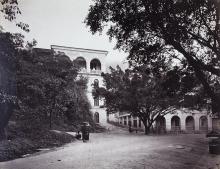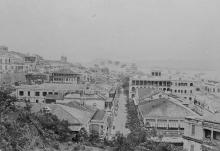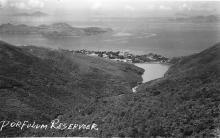Ice House - 2nd location [1862-1955]
Primary tabs
Not daunted by the failure of the first Ice Company,the Ice Association of Hong Kong was created about 10 years later after John Dent in 1862 sent round the prospectus. Government assigned to trustees I.L. 564, across the street from the former Ice House.
At first, the Ice Association tried to import their own ice. But the company lost money. So they then turned to the "Tudor Company", an American company which for several decades had been cutting ice from Boston, packed it tightly into ships and delivered it all over the world.
"The [U.S.] coastwise shipments are to all the seaports, from Philadelphia to Galveston, Texas; while the foreign market includes, besides the West Indies, and the West Coast of South America, Mauritius, Isle of Bourbon, Manilla, Calcutta, Madras, Bombay, Ceylon, Hong Kong, Whampoa, Batavia, and Liverpool."
The Western literary messenger - 1849
The Tudor Company agreed, and invested in rebuilding a solid ice House, in exchange for a guarantee 5 cents per pound for the ice. They held the lease at first, for 10 years.
In about 1873, two Scottish Engineers, Mr. Kyle and Mr. Bain, began making ice in Hong Kong at East Point, at their Hong Kong Ice Works. Between 1873 and 1880 Mr. Bain brought out several improvements in refrigerating machinery, and the went into competition with the Tudor Company who bowed out, sold their equipment to Kyle and Bain, who then leased the Ice House from the Ice Association.
They sold their company to Messrs Jardine, Matheson and Company in 1879, and Mr. Bain stayed on as manager of the Ice Works.
This is when the Govenment took notice - mainly that the Ice Association did not acutally hold title to the land. So Inland Lot No. 564 was leased for 999 years to the reamining trustee of the Ice Association - William Keswick - at a good price. He held it until 1908, and then sold it to the Hongkong Ice Company.
The low building on the right was where the first ice house was built. The tall building on the left, was the second one, after renovation in about 1888.
In 1918, Dairy Farm and the Ice Company merged, and the I. L. 564 was sold to Hong Hong Land.
In 1934, the Govenment resumed the property, and even the name Ice House was no longer used.





Comments
The "Opium Farm" is on Ice House Lane
"The Chinese" c.1909
The government of the Colony of Hong-Kong is supported to the extent of one third by the tax on the " Opium Farm," which is owned by the Chinese and Parsees. There is accordingly a great to-do in the Colony over the alarming prospect of increased taxation of property, when opiated China sobers up. Surprise is frequently expressed by travelers at the scenes enacted at the Canton Steamboat wharf at Hong-Kong in the name of British law and dignity. Chinese gentlemen are pounced upon by the minions of the local opium farmer and searched. There is far more blackmail than excise in the scheme. These detectives of all colors and records, the " beachcombers " of an occidental civilization tented on remote oriental sands for a season, abuse their authority flagrantly when they conclude that every Chinaman, poor or rich, is an opium smuggler at heart and that his baggage and home can be turned upside down at any hour of the night on the excuse of a suspected cache. The plan of rewarding informers has led to nothing short of a widespread system of fostering the latent secret society and clan spite. The "[opium] farm" is on Ice-House Lane in the center of the Colony, and visitors will know it by the great loads of mango boxes, gunny-covered, drawn to its gate by strings of nearly naked coolies.
Mee Cheung - Top floor of Ice House
Another photo, also not online:
A view along Ice House Lane, off Queen's Road, Victoria, with a row of sedan chairs parked at the right of the street. At the end of the lane can be seen the studio of Mee Cheung, a Chinese commercial photographer who advertises his premises in the 'Directory and Chronicle for China' (1901 ed) as being located at 'Top floor of Ice House'.
http://janus.lib.cam.ac.uk/db/node.xsp?id=EAD%2FGBR%2F0115%2FY3011B%28LS...
Ice House Street / Lane
Old maps (1867, 1889 plate 3-2) show the section of road south of Queen's Rd is called Ice House Lane.
A 1911 map (plate 3-4) shows it called Ice House Road. (It also shows 'Mee Cheung Photographer' on the southeast corner of the Ice House Lane-Road-Street / Queen's Road crossroads, where the Ice House building stood)
By the 1930s (plate 3-5b) it is called Ice House Street.
On all the above maps, the section of road to the north of Queen's Road is called 'Ice House Street'.
All plate references from the 'Mapping Hong Kong' book.
Re: Mee Cheung
Re: Ice House Street
1911 P. W. D. Annual Report
That portion of Ice House Street between Queen's Road and Des Voeux Road Central was paved with 6 inch wood blocks laid on cement concrete 4 inch thick, the total area being 760 square yards. Half of the street was laid with camphorwood and the remainder with Jarrah blocks.
Perhaps the wood pavings were to facilitate the transportaion of ice blocks.
"Another interesting building
"Another interesting building was the Ice House that stood at the junction of Battery Path and Ice House Street. In spite of its name, it did not manufacture ice. The ice was harvested from icebergs by The American Company and shipped to Hong Kong. The crop arrived in great blocks and was stored in the Ice House. At one time the company was owned by a dubious entrepreneur called George Duddell who ran an illicit craps game in the building. He was also a dishonest auctioneer who once illegally sold a ship to himself at a ridiculously low price... and got caught. In spite of this there is a street in Central named after the crook."
http://www.citylifehk.com/citylife/eng/history_0607.jsp
Added appx. demolition date 1955
Notes from 80skid:
we can also add that the Ice House Street part of West Wing replaced the original Ice House - presumably knocked down mid-1950s. The Ice House can still be seen in a 1949 aerial photo and marked on maps from 1950 according to the CGO research (pg 98-100: http://www.amo.gov.hk/form/research_CGO_e.pdf)